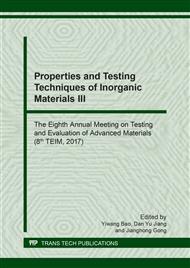[1]
M. Willander, M. Friese, Q.U. Wahab, B. Straumal, Silicon carbide and diamond for high temperature device applications, J. Mater. Sci.-Mater. El. 17 (2006) 1-25.
DOI: 10.1007/s10854-005-5137-4
Google Scholar
[2]
F. Bechstedt, P. Käckell, A. Zywietz, K. Karch, B. Adolph, K. Tenelsen, J. Furthmüller, Polytypism and properties of silicon carbide, Phys. Status Solidi B 202 (1997) 35-62.
DOI: 10.1002/1521-3951(199707)202:1<35::aid-pssb35>3.0.co;2-8
Google Scholar
[3]
D.H. Wang, D.Q. Wang, Y.J. Hao, G.Q. Jin, X.Y. Guo, K.N. Tu, Periodically twinned SiC nanowires, Nanotechnology 19 (2008) 215602.
DOI: 10.1088/0957-4484/19/21/215602
Google Scholar
[4]
G.C. Xi, Y.Y. Peng, S.M. Wan, T.W. Li, W.C. Yu, Y.T. Qian, Lithium-assisted synthesis and characterization of crystalline 3C-SiC nanobelts, J. Phys. Chem. B 108 (2004) 20102-20104.
DOI: 10.1021/jp0462153
Google Scholar
[5]
H.W. Shim, H.C. Huang, Nanowebs and nanocables of silicon carbide, Nanotechnology 18 (2007) 335607.
DOI: 10.1088/0957-4484/18/33/335607
Google Scholar
[6]
Y.J. Hao, J.B. Wagner, D.S. Su, G.Q. Jin, X.Y. Guo, Beaded silicon carbide nanochains via carbothermal reduction of carbonaceous silica xerogel, Nanotechnology 17 (2006) 2870-2874.
DOI: 10.1088/0957-4484/17/12/008
Google Scholar
[7]
M.S. Dresselhaus, Y.-M. Lin, O. Rabin, M.R. Black, J. Kong, G. Dresselhaus, Springer Handbook of Nanotechnology - Part A/4, Nanowires, Springer Berlin Heidelberg, (2010).
DOI: 10.1007/978-3-642-02525-9_4
Google Scholar
[8]
Q.G. Fu, H.J. Li, X.H. Shi, K.Z. Li, J. Wei, Z.B. Hu, Synthesis of silicon carbide nanowires by CVD without using a metallic catalyst, Mater. Chem. Phys. 100 (2006) 108-111.
DOI: 10.1016/j.matchemphys.2005.12.014
Google Scholar
[9]
J.W. Liu, D.Y. Zhong, F.Q. Xie, M. Sun, E.G. Wang, W.X. Liu, Synthesis of SiC nanofibers by annealing carbon nanotubes covered with Si, Chem. Phys. Lett. 348 (2001) 357-360.
DOI: 10.1016/s0009-2614(01)01113-7
Google Scholar
[10]
F.L. Wang, L.Y. Zhang, Y.F. Zhang, SiC nanowires synthesized by rapidly heating a mixture of SiO and arc-discharge plasma pretreated carbon black, Nanoscale Res. Lett. 4 (2009) 153-156.
DOI: 10.1007/s11671-008-9216-3
Google Scholar
[11]
T.L.Y. Cheung, D.H.L. Ng, Conversion of bamboo to biomorphic composites containing silica and silicon carbide nanowires, J. Am. Ceram. Soc. 90 (2007) 559-564.
DOI: 10.1111/j.1551-2916.2006.01390.x
Google Scholar
[12]
C. Vakifahmetoglu, Fabrication and properties of ceramic 1D nanostructures from preceramic polymers: a review, Adv. Appl. Ceram. 110 (2011) 188-204.
DOI: 10.1179/1743676111y.0000000007
Google Scholar
[13]
Y.J. Xing, Q.L. Hang, H.F. Yan, et al., Solid-liquid-solid (SLS) growth of coaxial nanocables: silicon carbide sheathed with silicon oxide, Chem. Phys. Lett. 345 (2001) 29-32.
DOI: 10.1016/s0009-2614(01)00768-0
Google Scholar
[14]
P. Zhang, X. Li, Microstructures of the silicon carbide nanowires obtained by annealing the mechanically-alloyed amorphous powders, Mater. Charact. 105 (2015) 82-89.
DOI: 10.1016/j.matchar.2015.05.003
Google Scholar
[15]
X.C. Li, X.H. Chen, H.H. Song, Preparation of silicon carbide nanowires via a rapid heating process, Mat. Sci. Eng. B-Solid 176 (2011) 87-91.
DOI: 10.1016/j.mseb.2010.09.007
Google Scholar
[16]
G.F. Iriarte, Large scale synthesis of silicon nanowires, J. Nanopart Res. (2010).
Google Scholar
[17]
S.Z. Deng, Z.S. Wu, J. Zhou, N.S. Xu, R. Chen, J. Chen, Synthesis of silicon carbide nanowires in a catalyst-assisted process, Chem. Phys. Lett. 356 (2002) 511-514.
DOI: 10.1016/s0009-2614(02)00403-7
Google Scholar
[18]
S.G. Sundaresan, A.V. Davydov, M.D. Vaudin, et al., Growth of silicon carbide nanowires by a microwave heating-assisted physical vapor transport process using group VIII metal catalysts, Chem. Mater. 19 (2007) 5531-5537.
DOI: 10.1021/cm071213r
Google Scholar
[19]
Alloy phase diagrams, Vol 03, ASM Metals Handbook, ASM international.
Google Scholar
[20]
B. Gabbitas, P. Cao, S. Raynova, et al., Microstructural evolution during mechanical milling of Ti/Al powder mixture and production of intermetallic TiAl cathode target, J. Mater. Sci. 47 (2012) 1234-1243.
DOI: 10.1007/s10853-011-5886-9
Google Scholar


